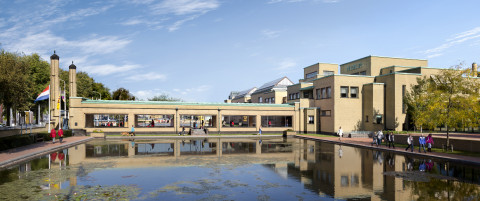
Plan your visit
Visit the Kunstmuseum The Hague. See our openinghours, entrance fees and read about other practical info.
Kunstmuseum Den Haag has a treasure chamber of over 160.000 pieces of art. Here we work on making the highlights from this collection available online.
In 1928 Pablo Picasso (1881 - 1973) went to see his old friend and fellow Spaniard Julio González (1876 - 1942) in Paris. He needed the help of the talented metalworker to turn a two-dimensional design into a metal sculpture. It was to be the start of a close partnership and the continuation of a unique friendship.
They worked together on a number of sculptures over a four-year period. For both artists, the collaboration provided a major push to further development. Thanks to González, Picasso discovered new modes of expression in sculpture and for González the collaboration was the final leg of his journey towards a distinctive artistic style. This exhibition at the Gemeentemuseum Den Haag focuses principally on González’s development from craftsman to avant-garde artist. With no fewer than 20 works by Picasso, it is also a celebration of the friendship between the two men.
Julio González encountered metalworking at an early age, in his father’s workshop in Barcelona. It seemed a matter of course to follow his father and grandfather into the trade and he learned a variety of metalworking techniques from the former. These enabled him to create decorative objects and jewellery, for which he won a number of prizes. Despite this success, he aspired to become a painter and started to show his work at the Paris salons, while at the same time continuing to earn his living by producing decorative objects in metal. At the end of the First World War he found a job in the Renault car factory, where he learned a sophisticated welding technique. Given his consequent mastery of metalworking techniques, it is no wonder that Picasso called on him for advice on working in metal, even though their youthful friendship had fizzled out many years earlier.
From 1928 to the end of 1932, González and Picasso collaborated on a number of metal sculptures that are now attributed to solely Picasso. It was thanks to González’s technical expertise that Picasso arrived at new forms of expression. In the first instance, González translated Picasso’s sketches into three-dimensional works. Later, once González had taught Picasso techniques like forging and welding, the two men worked together on sculptures such as the more than 2-metres-high La Femme au jardin (‘Woman in the Garden’) (1929). Influenced in part by his collaboration with Picasso, the 52-year-old González made great strides in his own artistic development and the works he produced from this period on can be seen as blazing a trail in art history. In the past, sculptures had always been carved from single blocks of stone or moulded in clay and only later cast in bronze. González changed this time-consuming process; by welding steel components together, he was able to create new works directly, without intermediate stages. The result was a highly distinctive and personal style.
The exhibition also examines the highly personal friendships that Julio González maintained with other artists. He worked for some years as an assistant to Constantin Brancusi (1876 - 1957). Pablo Gargallo (1881 - 1934), who drew on González’s technical expertise as early as 1923, recognized his artistic talent and encouraged him to devote himself entirely to sculpture. And it was in González’s workshop that his son-in-law, Hans Hartung (1904 - 1989), created his first and only sculpture in 1938.
Although González moved to Paris around the turn of the century, he continued to cherish his Catalan roots. A recurrent subject in his work is an indomitable Catalan peasant woman bearing a sickle and holding a child on her arm. Developments in the Spanish Civil War are reflected in González’s work, as they are in that of Picasso and other Spanish artists of the period. As the war went on, but especially after 1939, when General Franco seized power, González's indomitable female figures underwent a metamorphosis. Their faces were now screaming and distorted with terror. They display similarities with the wailing figures in Picasso’s Guernica (1937), several sketches for which are included in the exhibition. González’s more abstract 'cactus figures' of 1939 have similarly gaping mouths, although at the same time they radiate great strength. It is tempting to see them as symbolizing the fortitude of the Catalan people, standing firm in the face of their oppression by Francoʼs regime.
González, Picasso en vrienden
It is time that this metal cease to be [a] murderer and [the] simple instrument of an overly mechanical science. The door is opened wide to this material to be – at last! – forged and hammered by the peaceful hands of artists.
The exhibition is accompanied by a book of the same title, containing essays by Tomás Llorens, Marilyn McCully and Laura Stamps (Hannibal Publishing, price €29.95).
The exhibition is being held in close collaboration with Madrid’s Museo Nacional Centro de Arte Reina Sofía – which is providing a host of items, including the highly exceptional loan of Picasso’s masterpiece La Femme au jardin (1930-1932) – and with the IVAM in Valencia, the major centre of expertise on Julio González. The Musée Picasso and Centre Pompidou in Paris are also providing generous loans. Finally, the Gemeentemuseum Den Haag is grateful to Fund 21 and the Mondriaan Fund, without whose support this exhibition would not have been possible.